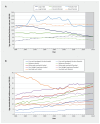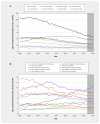Projected estimates of cancer in Canada in 2024
- PMID: 38740416
- PMCID: PMC11090635
- DOI: 10.1503/cmaj.240095
Projected estimates of cancer in Canada in 2024
Erratum in
-
Correction to "Projected estimates of cancer in Canada in 2024".CMAJ. 2024 Jun 2;196(21):E731. doi: 10.1503/cmaj.240712. CMAJ. 2024. PMID: 38830683 Free PMC article. No abstract available.
Abstract
Background: Cancer surveillance data are essential to help understand where gaps exist and progress is being made in cancer control. We sought to summarize the expected impact of cancer in Canada in 2024, with projections of new cancer cases and deaths from cancer by sex and province or territory for all ages combined.
Methods: We obtained data on new cancer cases (i.e., incidence, 1984-2019) and deaths from cancer (i.e., mortality, 1984-2020) from the Canadian Cancer Registry and Canadian Vital Statistics Death Database, respectively. We projected cancer incidence and mortality counts and rates to 2024 for 23 types of cancer, overall, by sex, and by province or territory. We calculated age-standardized rates using data from the 2011 Canadian standard population.
Results: In 2024, the number of new cancer cases and deaths from cancer are expected to reach 247 100 and 88 100, respectively. The age-standardized incidence rate (ASIR) and mortality rate (ASMR) are projected to decrease slightly from previous years for both males and females, with higher rates among males (ASIR 562.2 per 100 000 and ASMR 209.6 per 100 000 among males; ASIR 495.9 per 100 000 and ASMR 152.8 per 100 000 among females). The ASIRs and ASMRs of several common cancers are projected to continue to decrease (i.e., lung, colorectal, and prostate cancer), while those of several others are projected to increase (i.e., liver and intrahepatic bile duct cancer, kidney cancer, melanoma, and non-Hodgkin lymphoma).
Interpretation: Although the overall incidence of cancer and associated mortality are declining, new cases and deaths in Canada are expected to increase in 2024, largely because of the growing and aging population. Efforts in prevention, screening, and treatment have reduced the impact of some cancers, but these short-term projections highlight the potential effect of cancer on people and health care systems in Canada.
© 2024 CMA Impact Inc. or its licensors.
Conflict of interest statement
Competing interests:: Darren Brenner reports support from the Canadian Cancer Society and the Canadian Partnership Against Cancer. Ryan Woods reports funding from the BC Cancer Foundation, the Canadian Partnership Against Cancer, and Statistics Canada. Donna Turner reports support to attend meetings from the Canadian Cancer Society. No other competing interests were declared.
Figures


References
-
- Cancer survival statistics, 2020 update. Ottawa: Statistics Canada; 2020. Available: https://www150.statcan.gc.ca/n1/daily-quotidien/201127/dq201127b-eng.htm (accessed 2021 Apr. 15).
-
- Canadian Cancer Statistics Advisory Committee. Canadian Cancer Statistics 2023. Toronto: Canadian Cancer Society; 2023. Available: http://cancer.ca/Canadian-Cancer-Statistics-2023-EN (accessed 2024 Jan. 19).
-
- Liu JL, Zhang SX, Billette JM, et al. . Lifetime probability of developing cancer and dying from cancer in Canada, 1997 to 2020. Health Rep 2023;34:14–21. - PubMed
-
- Table 13-10-0111-01. Number and rates of new cases of primary cancer, by cancer type, age group and sex. Ottawa: Statistics Canada; modified 2024 Mar. 28. Available: https://www150.statcan.gc.ca/t1/tbl1/en/tv.action?pid=1310011101 (accessed 2024 Jan. 19).
MeSH terms
LinkOut - more resources
Full Text Sources
Medical
Molecular Biology Databases
